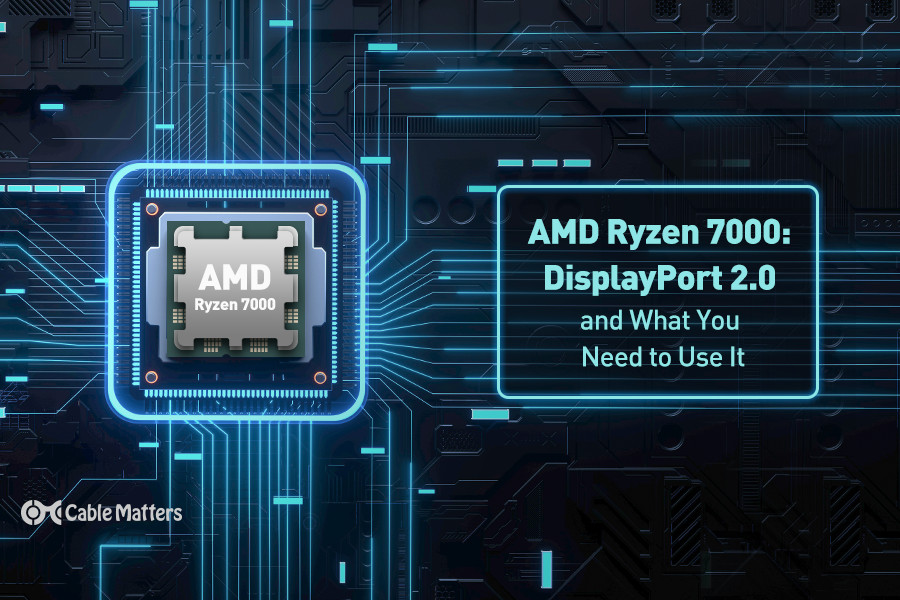
AMD has made a major pledge for its next-generation Ryzen 7000 processors based on its new Zen 4 architecture: DisplayPort 2.0 support. This long-awaited connection standard will offer an enormous leap in bandwidth and display capability when it’s released, and though the standard has been ratified for a few years, AMD’s Ryzen 7000 CPUs will be the first to offer official support.
At Computex 2022 in May, AMD announced support for the new port on its next-gen CPUs and supporting 600-series motherboards. Motherboards will be able to come with as many as four HDMI 2.1 or DisplayPort 2.0 ports, and with all Ryzen 7000 GPUs having onboard Radeon RDNA 2 graphics, owners will be able to power several ultra high-definition displays right from the CPU.
What is DisplayPort 2.0?
DisplayPort 2.0 is the next iteration of the DisplayPort standard and is the direct successor to DisplayPort 1.4. First standardized in 2019, DisplayPort 2.0 brings a much larger uplift in bandwidth than any previous generation, increasing it from 32.4 Gbps, to 80 Gbps. As with previous generations, various performance modes can be used, depending on the resolution and refresh rate of the content being transmitted, but ultimately DisplayPort 2.0 is the most capable video cable standard available.
It can handle a 4K display at up to 240Hz, an 8K display at up to 85Hz, and even a 10K display at 60Hz, all without any form of compression. If you take advantage of its display stream compression 1.2a (DSC) however, then DisplayPort 2.0 can support a single 16K display at 60Hz with HDR, two 8K displays at 120Hz with HDR, or up to three 4K displays at 144Hz and HDR.
DisplayPort 2.0 doesn’t introduce a range of new features as HDMI 2.1 did, but it does come with the new Panel Replay technology. This allows displays to efficiently only render a portion of a frame that has differed from the previous frame. That could help all-in-one devices save power and potentially even lead to a light performance uplift in some settings.
Like previous generations of DisplayPort, DisplayPort 2.0 will also see use in “alt. Mode” via alternative connector standards like Thunderbolt and USB-C. With many modern laptops making use of USB-C and Thunderbolt exclusively, it may well be that your most common exposure to DisplayPort 2.0 ends up bringing through its alternate mode connections – even if the first DisplayPort 2.0 devices will almost certainly be desktop PCs.
What Do You Need For DisplayPort 2.0?
There aren’t any displays or devices that support DisplayPort 2.0 at the time of writing, but they aren’t far off. AMD has made it clear that DisplayPort 2.0-compatible PCs will start arriving sometime in Q3 2022, which means we’ll likely start seeing supporting displays arrive just before or around that time too.
When both are available, you’ll need at least one of each to make the most of either, but once you have them, you’ll need the right cable to connect them. Run a high-quality DisplayPort 2.0 cable between them and you’ll be able to start enjoying new, higher-resolution, and high refresh rate content – assuming your PC or other supporting devices can handle it in turn. While DisplayPort 2.0 might open up the possibility of new, more detailed, and faster displays, they will demand faster CPUs and graphics cards too.
What’s Next For DisplayPort 2.0?
Like DisplayPort 1.4 before it, DisplayPort 2.0 is likely to become the common solution for high-end desktop PC monitors for higher resolution and refresh rate gaming. With the ability to deliver 8K and even 10K without any kind of compression or color alteration, DisplayPort 2.0 will likely feature on next-generation graphics cards on desktop PCs in the future, while games consoles, even Microsoft and Sony’s mid-generation refreshes, will likely stick with HDMI 2.1.
The question now arises of which range of graphics cards will first offer DisplayPort 2.0 support. Neither AMD nor Nvidia have mentioned it so far, but with both AMD’s RDNA 3 and Nvidia’s RTX 4000 cards set to launch before the end of the year, we may only be a few months away from a whole range of hardware with DisplayPort 2.0 support.
As with previous-generation graphics cards, they’ll likely offer limited HDMI 2.1 support too, though they may well come with DisplayPort 2.0 over USB-C support also, as we saw with Nvidia’s short-lived Virtualink port, which was previously planned for use with virtual reality headsets.